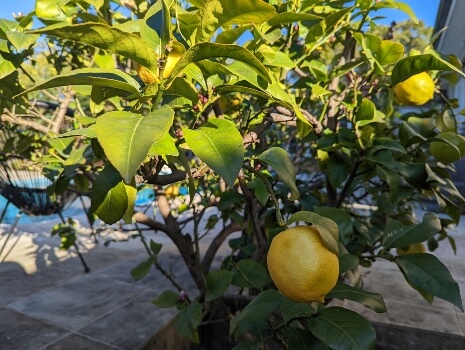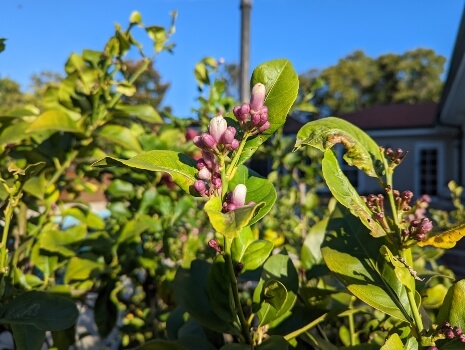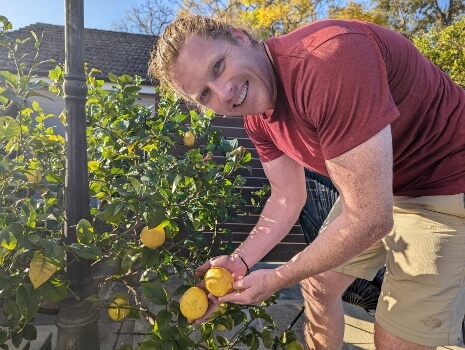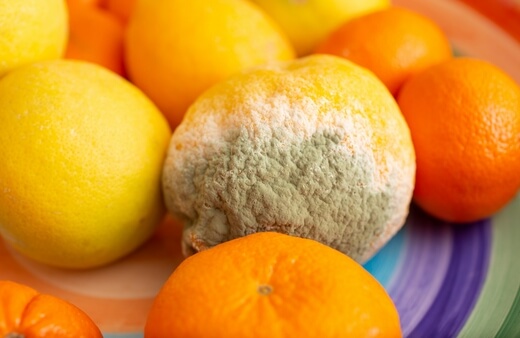Any citrus tree you add to the garden will bring years of joy, but there’s something uniquely wonderful about growing your own lemon tree at home. The sweetness of fresh, sun-ripened lemons is unbelievably lovely and cuts through the zippy sourness beautifully.
In this article, we’ll run through everything you need about how to grow lemons at home, as well as some lesser known facts about these gorgeous trees that make them perfect for any garden, regardless of their fruit.
More...

Family: | Rutaceae |
|---|---|
Genus: | Citrus |
Species: | C. limon |
Common Names: | Lemon tree |
Location: | Outdoor |
Type: | Fruit tree |
Growth: | 10-12m tall |
Sun requirements: | Full sun |
Foliage Colour: | Green |
Flower Colour: | Pink and white |
Flowering: | Spring |
Fruit: | Large, yellow, citrus fruits |
Maintenance level: | Medium |
Poisonous for pets: | Stems and leaves are toxic to cats and dogs |
Getting to Know Lemon Trees

Nathan Schwartz of Aussie Green Thumb enjoying his freshly picked lemon
Lemon trees are an iconic member of the citrus family, with large, custard-yellow fruits covered in flavourful zest and packed with essential oils. The beauty of these trees goes far beyond just their fruit though, with flowers filled with a sweet, vanilla-like scent, with heavy citrus overtones produced early on in spring as the bright, lime-green leaves begin to unfurl.
Because Lemons are hardy down to about 7°C, they are perfect for most Australian homes and can be planted straight into the ground. For others, planting them in a container is a must, so you can move them back into the greenhouse for winter.
Lemon trees grow to around 10 m tall in their natural habitat but are easy to keep small for easy maintenance, and accessible fruit picking. Most sold for garden growing are grafted onto dwarf rootstock, which helps to keep them smaller for longer too.
Lemon Tree’s Natural Habitat
Lemons are one of the first instances of deliberately hybridised plants. Though their origins are not completely understood, they are a cross between bitter orange and Citron medica (normally known simply as Citron), a distinctly fragranced fruit, packed with citrus perfumes, and used in traditional Asian cuisine and medicines.
Due to their genetics, it is thought that lemons were most likely bred in Assam in northeast India, Myanmar or China. Throughout the 1st and 2nd centuries, lemons were cultivated and distributed across Mediterranean and tropical climates where they thrived thanks to high temperatures, good drainage, and reasonably reliable rainfall.
In our gardens, replicating that with fertile soil, good drainage, and full sun is the best way to produce ripe, juicy, thicken skinned lemons, packed with as much flavour as possible.
How to Grow Lemon Trees in Australia
Lemons can grow in a multitude of conditions, but prefer fertile, well-drained soil in full sun. They also need protection from frost and, ideally, temperatures below 7°C. Follow our grow guide for lemon trees below for everything, from planting to harvesting.

Planting Lemon Tree in a Container
The easiest way to get started with lemon trees at home is to plant them in a container. Because of their need for excellent drainage, terracotta pots are the best option, as they allow water to transpire out of the pot wall, and can actually help to manage humidity.
Find a pot that’s about twice the size of the root ball of your lemon tree, and pack it with an even mixture of sand, grit, and compost. Plant your lemon tree just above the soil level, leaving at least an inch between the surface of the soil and the rim of the container. This is incredibly important!
That empty space you left at the top of the container will now be filled with water, and a good quality organic liquid feed, like liquid seaweed (1 cap to 1 gallon of water). Let that drain through, and repeat until water runs out of the base of the pot.
Water like this once every week, or whenever the soil surface dries out for the first year.
Note: Some gardeners opt for pure garden soil. That can be beneficial in the long run, if you intend to plant your tree out once it’s a little bigger. Essentially, if you’ve got reasonably fertile, well-drained, sandy soil in the garden, plant your tree into that, in a container, and feed it well for the first few years.
After that, it will be less likely to suffer from transplant shock when it goes out into the ground.
How to Grow Lemon Tree Outdoors
If you’ve bought a substantial lemon tree, that’s big enough to plant straight into the garden, and you live anywhere with warm winters, it’s safe to plant your tree directly into the garden. Check that your soil has good nutrient levels, and that it drains properly first. After that, just find a good sunny spot, with shelter from high winds.
If you’re considering how the garden works as a whole, plant your tree somewhere near a patio so you can smell the flowers and the fruit on warm evenings. Lemons don’t have the same powerful fragrance as other citrus fruits, but their delicate aroma is a gorgeous addition to any patio.
Start by digging a square hole that’s at least twice the size of the existing root ball. Digging a square hole encourages roots to grow outwards, rather than spiralling around. Then plant your lemon tree so it’s about 1-2 cm above of the soil surface. Backfill the hole with garden soil, regardless of nutrient levels.
Now your tree is in the ground, make sure it’s really well watered. Use a good quality liquid seaweed to feed your lemon tree for the first few weeks. For the initial watering, add a single capful to the watering can, and drench the soil. Then mulch with any organic compost or bark chippings to help lock in moisture.
How to Propagate Lemon Trees
Before we get started with any propagation advice, it’s worth noting that patience is always a virtue for gardeners. For gardeners hoping to get a harvest from self-propagated citrus trees, that patience will be harshly tested.
Like all citrus trees, lemons take about 6 years minimum to produce fruit, and it is usually more like 10-15 years before any meaningful harvest could be expected. That being said, the trees will still produce beautiful blossoms, and stunning, waxy green foliage from spring through to autumn, so are worth growing for ornamental appeal.
And as a bonus, you’ll get a bountiful harvest long after you’ve given up on the possibility.

Propagating Lemon Trees from Seed
Growing lemons from grocery store seeds does have its limitations, with anywhere between 6-15 years before you’ll see your first fruit. And even then, there’s a risk that the lemon you harvested seeds from could produce slightly different fruits.
If you want to be sure of the tree you’ll be growing, try using a named variety of lemon, and buy unwaxed lemons; the seeds can often be over-humid in waxed lemons and struggle to germinate.
Choose something like a Sicilian lemon (usually these are true to the Sicilian Femminello Santa Teresa lemon tree, so have a good chance of fruiting after 5-6 years).
To propagate lemon seeds:
- Squeeze the juice from your lemon, zest it, and use it for whatever culinary delight you have planned (nothing needs to go to waste).
- Pick out the seeds from the juicer, and dry them gently with a paper towel to remove excess moisture.
- Note: there is no need to peel the skins from lemon seeds.
- Plant them quickly, in a sandy compost mixture, about 2cm deep.
- Water the pot until it runs out of the base.
- Cover the pot with a plastic bag or cling film to raise the humidity.
- Place your seed pots somewhere warm, with 4-6 hours of direct sunlight per day.
- Seeds should germinate after 3-4 weeks.
- Leave the plastic film on until they develop a healthy pair of leaves.
- Continue to care for the lemon seedlings by watering them when the soil dries out.
- When they reach 15-30 cm tall and have multiple leaves, pinch out the top growth to create a wider canopy, and encourage more foliage.
- Then, begin to feed them with a very diluted liquid seaweed once a month.
- When roots have developed and are showing out of the base of the pot, pot them onto a pot that’s twice the size, and care for them like any other citrus tree.
Propagating Lemon Trees from Cuttings
Lemon trees will fruit slightly faster from cuttings, but that means you’ll need access to an existing tree that’s fully mature and already fruiting. Thankfully, the process is pretty simple, and you’ll get healthier, bushier, growth, much more quickly this way.
In the second year, your young lemon tree should flower, but any fruit will be too small to use, so should be removed to focus energy on root and branch development.
To take a lemon tree cutting:
- Find a young, flexible branch without flowers, buds, or fruit.
- Cut just below a leaf, taking 15-20cm of the branch for your cutting.
- Clean up the cut on the parent plant by cutting back to above the next leaf. This will just tidy up its appearance, and encourage new growth from that node.
- Remove all but the topmost leaves from the cut branch, and gently insert it into a deep pot, filled with gritty compost, or a 50:50 mix of compost and vermiculite.
- Like any semi-ripe cutting, drainage is key to success, as excess moisture will rot the stem before roots form.
- Leave your cutting somewhere warm, humid, and away from direct afternoon sunlight until new leaves appear. Gently water when the soil starts to dry out. In warm summer, mist the top growth too to help reduce water loss.
- After 1-2 months you should notice new growth in the form of ripening leaf buds along the stem. As these open out, start to feed your cutting with a very low dose of liquid seaweed once a fortnight.
- When roots start to poke out of the base of the pot, it’s time for a new container, and more light.
- Plant your lemon tree cutting into a terracotta pot, and feed and water as you would with any other citrus plant. After 5-6 years, if you’re lucky, you’ll have fruit.
Caring for Lemon Trees
Once your lemon trees have matured and established in the garden, caring for them is pretty straightforward. Mulching once a year, and keeping them from completely drying out is all you need for a beautiful flowering tree.
To get as much fruit as possible from each tree though, you’ll need to pay closer attention to how and when you feed them.

Mulching lemon trees
Lemon trees, whether they’re in the ground, or in a container, need the same level of mulching. Once a year, refresh their nutrients with compost or trap in moisture using bark chippings.
In cooler areas, apply a thick mulch in late autumn to keep the roots warm over winter. In warmer areas, leave the soil bare over winter, and mulch in spring to trap in moisture as the weather warms up.
I prefer to use compost for both, and mulch in late autumn, which helps to keep the soil warm over winter, and feeds the roots ready for spring, but I know of many growers who swear by bark mulch thanks to its relatively low nutrient content.
The neutrality of bark mulch gives you greater control of feeding through the rest of the season.
Lemon tree fertiliser
Lemon trees are surprisingly hungry plants. The clue is in the fruit, with its thick rind, flavourful zest, and juicy centre surrounding chunky white seeds. All of that takes a lot of energy to produce and, as we’ll learn later on, lemons can continue fruiting pretty much all year round, so there’s no time to be forgetful.
I always use liquid seaweed to feed my lemons. You can make your own at home by filling buckets with seaweed and adding just enough water to cover the compressed materials, then apply weight by placing bricks over the top.
After a few months, you’ll have rich fertiliser that can be diluted in water. An easier approach is to buy concentrated liquid seaweed. My favourite is the basic Seaweed Plant Food Concentrate from Maxicrop, which provides everything your lemon tree needs.
Water requirements of Lemon trees
Lemon trees grow well in surprisingly arid conditions, but giving them an extra boost once in a while really will help them to produce more fruit. I live in a cool part of the country, so I water my lemon trees once every two weeks, but in warmer areas, once a week should suffice.
Essentially, when the soil surface is dry to the touch and just below the surface has just a little bit of moisture left, water your plant completely.
Water containerised plants so that water runs right through the base of the pot, saturating the soil completely. Watering like this mimics their natural environment, with rare but heavy rainfall in summer.
Repotting Lemon trees
Repotting lemon trees is important, but you can actually hold off that process by using a method called root pruning. Essentially, making the lemon tree work harder for nutrients, which both stunts its growth, and can give you an extra two or even three years in the same pot.
Ideally though, developing lemon trees should be potted on to a slightly larger pot every two or three years. When the roots begin to wind around the edge of the pot, they can constrict themselves and will develop yellow or pale foliage.
When you repot a very young lemon tree, like a cutting, or a sapling, pot on to a pot that’s double the size. For all other trees that have started producing fruit, pot on to give an extra 1-2 inches of soil around the root ball.
Pruning lemon trees
The middle of winter is a great time to prune a lemon tree or any type of citrus. It’s the small window of opportunity you get with citrus trees where most of the fruit has become harvestable and it has only just started blooming new buds. If you wait any longer then the tree will be covered in new buds and if you prune any earlier then you will lose most of the still immature fruit.
When pruning citrus you will have to forego some of the fruit as there will always be some unripe ones left. Yet this is a small price to pay for the abundance of fruit you will yield next season after your tree has been pruned properly now.
So, how do you go about pruning lemon trees? Here are some starting points;
Cut out any dead or diseased wood. Often branches will have snapped during the growing season either due to the weight of the fruit or from extreme weather conditions, or both. This kills the branch yet still leaves it hanging from the tree. If you don’t cut these limbs off then it can become an entry point for disease.
Prune any branches that are becoming a hazard. If your lemon tree is on the edge of a path like mine is then invariably it will grow branches that hinder your travel. Many times I’ve been crowned by a bunch of green fruit and apart from being dangerous these limbs can just be downright annoying.
The next step is to reduce the remaining limbs by about 1/3 in height. This does two things; (1) it allows the tree to bush rather than continue its journey heavenward, and (2) it allows next year's fruit to be accessible.
Once the above steps have been completed you will be able to stand back and consider the plant’s balance. Any criss-crossing limbs or branches that grow inwards should now be pruned to open up the canopy and allow light and airflow into the tree. This enables the fruit to ripen better and helps avoid future disease.
Now that your pruned citrus is finished it’s time to mulch the removed limbs for your compost and then fertilise your lemon tree with a generous dose of urea and a well-rotted cow or sheep manure. This will get your tree back up and sprouting new growth in no time and it will certainly reward you for your effort.
The above listed steps will work for any citrus tree whether it be mandarins, limes, grapefruit, oranges or cumquats. The main consideration when pruning citrus is that your tools are clean and sharp and any cuts made on a limb are one action without damaging the branch.
See our in-depth guide on choosing the best pruning shears for your daily gardening needs.
How to Harvest Lemons

Nathan Schwartz of Aussie Green Thumb harvesting lemons
Here’s the really exciting bit about lemons; they just keep going. Once a lemon tree starts producing fruit, it can fruit for up to twelve months a year. However, it’s best to try to give your trees some rest over winter, particularly in cooler climates.
Fruit that hasn’t ripened before winter can be left on the plant to develop, but in most parts of the country, it's best to stop feeding, and put your trees into forced dormancy in a greenhouse, with minimal water, and no feed.
Picking ripe lemons is rewarding for all the senses though, with the scent released by simply touching the ripe fruits, and lasting on your hands for hours thanks to the skins that are packed full of essential oils.
Unripe lemons are green and slowly turn to a bright, custard-yellow colour as they ripen. To check if they are completely ripe, push the fruit backward toward its branch. If it pops off easily, it’s ready.
Follow our video guide for a more in-depth look at how and when lemons are ready for harvest:
Lemon Tree Pests and Diseases to Look Out For
When it comes to protecting lemon trees from pests and diseases, there’s good news, and there’s bad news. The bad news is that there are literally dozens of pests and even more diseases that can affect lemon trees.
The good news is that lemon trees are incredibly resilient plants, and rarely suffer from any of them to a degree that would kill them. With that in mind, let’s take a look at the most common lemon tree pests and diseases, so you know what to look out for, and how to stop them before they spread.
Lemon Tree Pests
Citrus leafminer
Citrus leaf miners are the larvae of the citrus moth (Phyllocnistis citrella). They tunnel into the leaves and eat away below the surface. The only real way to spot them is to hold a leaf up to the light, where you’ll notice channels of grey or white and a tiny caterpillar’s silhouette at the end.
Young trees are most at risk from leaf miners, which cause very little damage to mature plants. Spraying them with horticultural oil will remove the problem, but wasps and omnivorous thrip species will usually control them naturally.
Light brown apple moth
The caterpillars of the light brown apple moth are voracious feeders on almost all fruit trees and are not put off by the strong essential oils of citrus trees. The caterpillars are easily noticed by the protective webbing, where they hide to feed.
Chili oil, mixed with water and sprayed onto the foliage will deter the moths from landing, and make the leaves less palatable for the caterpillars.
Lemon bud moth
Lemon bud moths are perhaps the most frustrating pest species to find on your lemon tree. They cause little to no harm to the health of the tree, but can completely ruin your harvest. The caterpillars are tiny (about 1cm long) and live in, and feed on, the unopened flower buds in spring.
As they feed, they deform the plant’s ovaries, and the cell structure will adapt, causing misshapen fruit which fails to ripen. Spraying plants with diluted crushed garlic in spring is usually enough of a deterrent.
Native budworm
Budworm, native to Western Australia, feed on the shoots and unopened buds of lemon trees in spring. Again, they cause little damage to mature trees, but a large population can cause fungal problems, and allow bacteria to enter the plant through bite wounds.
Spider mites, and citrus bud mites
Spider mites are the most common form of mite in any garden, and are generally put off by strong essential oils in plants, but do seem to have taken a liking to our lemon trees in recent years. Their damage is mostly on foliage and can be rectified by upping watering, and increasing humidity to discourage them.
Citrus bud mites are a whole different story though, as they are active every day of the year, and hide inside unopened buds. The most common sign of citrus mites is unopened flowers or deformed fruit, so they are commonly mistaken for lemon bud moths.
Native wasps will help to manage the problem, but like with all mites, healthy plants are less likely to be attacked.
Citrus gall wasps
Citrus gall wasps are one of the few pests that can cause real damage to your lemon trees. They reduce fruiting, and cause widespread damage to citrus trees, particularly in densely cultivated spaces.
The wasps lay their eggs in the stems of plants, and as they grow, their larva feeds on the nutrients being passed up the stem, creating a swollen gall that will look dry and pale brown.
If you suspect citrus gall wasps, you can report them to the Pest and Disease Information Service in your local area. Then, cut off the affected growth and burn it to stop the spread.
Aphids, thrips, scales, mealybug, and whitefly
All of the basic honeydew-secreting insects will land on, and colonise lemon trees, particularly in spring and early summer. They feed on young shoots and can drain leaves of their chlorophyll. However, they pose little threat to mature trees.
Similar to other biting pests, their main threat is that their bite wounds allow fungal and bacterial pathogens into the plants, causing problems later on.
Weevils
Weevils are perhaps the most common pest with any Mediterranean plant. For some reason, they are particularly attracted to heavily scented plants, rich in essential oils.
There are dozens of weevil species in Australia that can affect lemon trees, but they are all identifiable by their beetle-like bodies, with elongated thoraxes, and tiny heads. Weevils do not fly, so are quite easy to dispose of.
By wrapping cardboard or sheep wool to your tree trunks in summer and autumn, weevils will congregate in the evenings. Go out with a torch, and just dispose of the cardboard, and any hiding weevils in whatever way you see fit.

Lemon Tree Diseases
Melanose
Melanose is a frustrating, but manageable, fungal disease caused and exacerbated by dead wood. Regular pruning and removal of any dead or damaged wood should stop any occurrence of melanose.
To spot melanose, look for raised black or brown lesions on your fruit. Minor cases will be limited to the stem that connects the fruit, and as it spreads the fungal lesions create swathes of dark skin across lemons. Avoid wetting foliage and fruit, and apply copper sprays.
Lemon scab/citrus scab
Lemon scab, or citrus scab, is caused by the fungus Sphaceloma fawcettii. It looks, quite literally, like a scab on the skins of ripening lemons, and is distinctly cinnamon coloured, with dark centres in a cluster of pale, sunken brown skin.
It is spread by wind and rain, so more common in large collections of lemon trees, but can travel on the air for several miles. Any fungicidal spray will reduce recurrence, but remove any affected fruit or foliage and burn it when noticed.
Armillaria
Armillaria luteobubalina is a native fungus in Australian coastal areas, which affects the roots of most fruit trees. Thankfully, it is rare, but if it is present in your garden it is essential that you have it professionally treated, or stop growing fruit trees of any kind for at least six years, as the fungal spores can live in dead stumps and roots for 4-5 years with ease.
Direct contact between the roots of infected trees causes rapid deterioration of fruit tree roots. In its early stages, fruit and leaves will develop green lesions. Exposing the roots to air, and allowing them to dry out can kill the fungus though. So if you catch it early, try repotting it in isolation.
Botrytis
Botrytis, or grey mould, can affect flowers, leaves, stems, buds, and fruit on lemon trees. It is a very simple sporing fungus and can be treated with any fungicidal treatment.
Removing affected foliage early on will vastly reduce the chance of cross-infection too. If you notice botrytis, don’t worry, just act fast!
Phytophthora root rot
If you notice that sections of your lemon tree are looking incredibly dry, wilting, or even dropping their leaves and flowers, but the rest of the tree is happy and healthy, it’s most likely down to Phytophthora root rot.
This fungal root rot prevents roots from taking up moisture, and as the fungus develops the same symptoms become clear across the whole plant. Remove the affected top growth, and reduce watering until the root ball or soil around the tree dried out.
Overly wet soil encourages the spread of infection. Treating the soil with copper fungicides will also help to slow down the spread. For lemon trees in containers, repot them, but cut out any infected sections of black, brown, or mushy roots first.
Lemon Tree Frequently Asked Questions
How long does it take to grow a lemon tree?
If you’re growing from seed, you can expect your lemon tree to reach a reasonable size within 5-6 years but should be prepared to wait at least ten to see any reasonable fruit. Lemon trees bought from garden centres are often dwarfed, and ready to start fruiting immediately.
Also read: Growing Dwarf Citrus Trees for Small Gardens
Is Epsom salt good for lemon trees?
Epsom salt, like many power-based fertilisers, is a useful source of magnesium for lemon trees. If you notice signs of magnesium deficiency in your lemon tree, it’s worth considering if you don’t already give magnesium in other fertilisers.
How many lemons can one tree produce?
Lemon trees, once established, are incredibly productive trees. Mature, fully-grown lemon trees can produce well over 500 fruits in a single year when they reach 8-10m tall. Potted lemon trees will produce considerably less, but you can still expect 30-40 lemons from a small patio lemon tree in an average year.
Interested to growing more citrus trees in your garden? Check out our comprehensive guide to growing Yuzu or Japanese Lemon in Australia.
Wrapping Up Our Lemon Tree Guide
Some of the pests and diseases might sound like a horror story for lemon tree growers, but the reality is that 99% of lemon trees will live their lives quite happily, never knowing the trials of these growing problems.
All you need to do is keep a vigilant eye out, and remove signs of fungal or bacterial infection when you spot it. Other than that, growing lemon trees is just about feeding, watering, and finding the right spot.
With that done, you’ll be enjoying spring fragrance and summer fruits your lemon tree would bring to your garden for years to come.
Published on November 19, 2022 by Maisie Blevins
Last Updated on February 25, 2024




